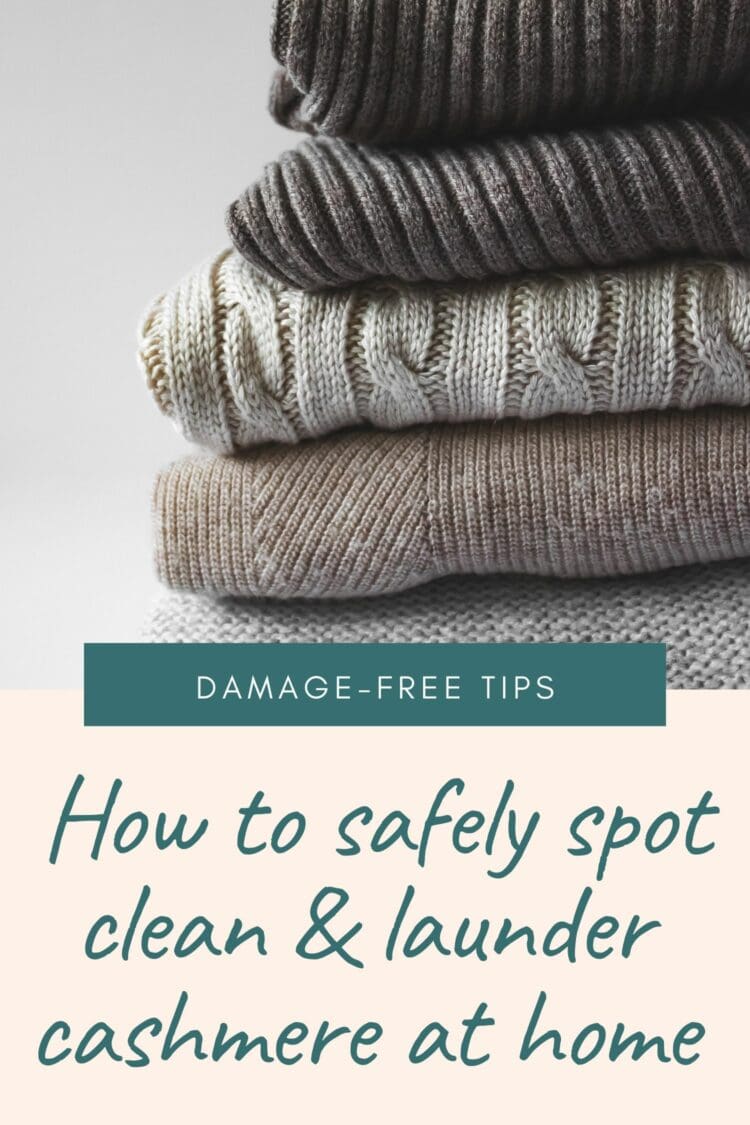How to Care for Cashmere When You Have no Time or Patience

For many years, I refused to buy cashmere sweaters because they seemed too difficult to care for. I had no desire to hand wash and gently swish, and I had no room in my small home for fancy drying racks. When I had a job that required a lot of suits and dry clean only clothes, I took my cashmere sweaters to the dry cleaners, but they often came back flattened and smelling a bit like chemicals. Then, I learned how to care for cashmere when you have no time or patience.
How to Care for Cashmere When you Have no Time or Patience
Cashmere seems so complicated. So many experts believe you need to wash cashmere in a bowl and reshape and scrunch just so as not to stretch it. You need fancy detergents or no detergent and the gentlest of cleansers. Caring for cashmere is a multi-step, complicated process, but it provides you with decades of cashmere sweaters that remain looking new. I agree that such methods are the best for preserving cashmere. However, we are grown-ass women with busy lives, and few of us have the time or patience for hand-washing our delicates.
That doesn't mean you can't own cashmere and have it look great for dozens and dozens of wears. Below, I share how to care for cashmere when you have no time or patience: how I launder it at home, how I refresh it between washes, and how I successfully spot clean cashmere.

How to Launder a Cashmere Sweater at Home in Your Washing Machine
Did you know you can wash cashmere in your washing machine? Now, I'm not saying throw it in there with your jeans and towels, but cashmere can be washed in the machine in a manner I use for many of the items I used to take to the dry cleaners:
- Place your cashmere sweater alone in a mesh washing bag. the bag keeps a sleeve from getting caught on the agitator or other clothing and having anything stretch.
- If your sweater has a closure, close it. Zippers, snaps, buttons… have them all secured. I usually wash my cardigans inside-out so the buttons are less likely to rub or snag anything else.
- Wash in the machine on the gentle cycle. I recommend if your machine permits, to choose full load but only have it half full of clothes so everything can swish around with lots of space.
- When it comes to detergent, I don't buy a fancy one but I do choose a liquid. Since you're using the gentle cycle and cold water there is less agitation and I find liquid to be more effective. I really like Dirty Labs, which is eco-friendly, allergy-friendly, and effective yet gentle to clothes.
- Take your cashmere out the machine and place on a bath towel. Make sure this bath towel is either a light color/white or has been laundered so often the color won't transfer.
- Flatten your sweater so there aren't any wrinkles. Cross the sleeves over the front like you'll pack it in a suitcase carefully.
- Now roll up the towel with the sweater inside. This will squeeze out excess water without stretching or misshaping your sweater. You don't need to be precious with this, and some skip this step altogether. It just helps the sweater dry faster and reduce the chance of it stretching while wet.
- Lay flat to dry. Using a clothing hanger can cause a cashmere sweater to stretch, so choose a drying rack (this one is cheap and great for small spaces). If you don't have a drying rack, you can just lay your sweater on a dry and clean towel and maybe flip it after a few hours so both sides get airflow.
I know I should have some PSA that you should spot test your cashmere before going all in with the washing machine. I have never done this, and have never had a standard (not embellished or super thin/delicate or handmade) sweater not handle the machine. But just because I haven't doesn't mean you shouldn't.
My Cashmere is Just a Bit Stinky But Not Dirty. How Should I Care For It?
The less you launder your clothes, the longer they will be a beloved item in your closet. If your cashmere isn't dirty but maybe smells a bit like your body/your dinner last night/your relative's smoky car, no need to actually wash it to make it smell great.
Between wears, I steam my cashmere sweaters. Just by using a small garment steamer (this one is great and has worked for me on travel and at home for a while), you can steam the funky parts (or the whole sweater) and then let it cool/dry in a well-ventilated area.
To let it air out, don't hang it on a hanger like a usual top; cashmere can stretch especially when damp. I recommend using a drying rack or use this tip on how to safely fold sweaters on a hanger.
A fabric refreshing spray can also do wonders for a sweater that smells like something you don't want it to smell like. I do NOT recommend Febreeze for your sweaters. I like Bac-Out, which is free of artificial fragrances and weird chemicals. If that kind of scent isn't your jam, it's easy to make your own fabric refresher at home.
DIY Fabric Refresher for Cashmere and Other Fabrics
Grab yourself a spray bottle and add to it:
- 1/2 cup of water
- 1/4 cup of vodka (some say you can replace this with rubbing alcohol but I haven't tried it myself)
- Optional: a few drops of your favorite essential oil
Some recipes include baking soda, but I haven't tried that. I do the recipe above with about 10 drops of essential oil (I haven't found any oil to do better than others so use what makes you happy). Spray the item and then follow the instructions for steaming and let it dry in a well-ventilated area.
Once it is dry, there will be no smell of alcohol (and little to no smell of the essential oil) and your funk will also be gone! This spray also works on furniture and other upholstery.
My Cashmere is Fine Except for One Spot! How Do You Spot Treat Cashmere?
I am a klutz and even if I am being careful, I am likely to spill something on my clothes. I have become a spot-removing expert thanks to this. And for cashmere, I find the best product for spot removing is baby shampoo.
I keep a bottle of ordinary baby shampoo in my laundry area. If I get a stain on my cashmere, I apply the baby shampoo to the dry sweater, use a clean cloth to blot/press it into the fabric, and then will rinse the area. Then I will put a towel inside the sweater, use another towel or cloth to blot out moisture, and let sit until dry. This usually works and won't leave a ring.

My Cashmere has Fuzz Balls All Over It! How Can I Safely De-pill Cashmere?
It is totally normal for cashmere and wool sweaters to get fuzz balls on it (also known as pilling). Pilling usually happens where the fabric rubs against itself or something else. You will often find pilling under your arms, along the sides of a sweater, and on the cuffs of sleeves. It's easy to remove these fuzzballs and have your sweater look like new again. Removing these fuzzballs will not create bald spots or thin your sweater if you use the right tools.
I have both this sweater stone and this fabric shaver and have used both successfully on cashmere. For ribbed and textured cashmere, I prefer a sweater stone since it's gentler, and won't mistake a cableknit for a fuzz ball. However, for smooth and thicker cashmere, a sweater shaver is faster and more accurate.
When Should Cashmere Be Dry Cleaned?
If I have a cashmere sweater with any embellishments (beading, sequins, buttons, metallic finish, leather trim, etc.) I don't mess with it and take it to an expert. I have tried, and have found such embellishments to not handle water well; it's not worth the risk.
If a label says do not wash, don't wash it. That usually means there is some fiber or treatment to the garment that won't respond well to being submerged in water. However, usually, if it says dry clean it's okay to launder at home. On the other hand, if it says do not dry clean do not. The chemicals from dry cleaning could damage the yarns or embellishments.
How to Store Cashmere at the End of the Season
Make sure your cashmere is free of stains, sweat, and body oils before storage at the end of the season. Dry cleaning is a good way to kill any eggs or larvae in your sweater that may eat the yarns while stored. Steaming is another way to rid your sweater of any pests, but sure it's completely dry before storing it for the summer.
Cashmere is best when folded into a breathable fabric storage bag or box. You can add cedar blocks or lavender sachets to assist in keeping moths and critters at bay. For more sweater tips, check out this article where I got knitwear advice from an expert!






My laundry has been the site of several disasters when other family members get to the washer before I do and throw my gently washed things into the dryer so they can wash their favorite gym shorts.
I say wear a t-shirt under your cashmere, wrap a silk scarf around you neck – so you don’t sweat or transfer oil to the sweater, spot clean drips, and only actually wash the sweater when you’re putting it away for the Summer so the moths aren’t attracted to the tasty spots.
If you’re only washing it once a season then wash it by hand and lovingly block it out on the towels.
We wash our sweaters far too often. Many wool and cashmere experts recommend these fabrics should be washed as little as possible and only when absolutely necessary. I always wear a thin t-shirt under sweaters and air them in between wears to ensure they stay fresh.
Hi Alison –
Thanks for this. I’ve been looking for a reliable steamer. The Rowenta you linked to comes in a variety of wattages — which one do you recommend? Thanks!
Hi Rosie, I have the lower wattage one but if I could go back I’d get the higher wattage so it would work better on heavier fabrics and drapes.
I machine wash both my merino wool and cashmere sweaters. I use a net bag, but I add one step: I turn the sweaters inside out, as this reduces friction on the “good” side of the sweater, helping reduce wear and tear and pilling. I use wool lite or something similar. Thanks for all the tips, Allie, and I hope you and your sister are doing well after losing your mom. And so suddenly. Hugs to you–I know you loved her very much.
That drying rack is genius – ordering! 🙂 Thanks for sharing!
100% if is says DO NOT dry clean, than I don’t, assume either its not color fast or that the thread or other non wool elements have not been treated or tested for a wet wash.
I do make sure that i dry clean at the end of the season as its the only way i know to insure that any moths that might be lurking are killed. If anyone knows another way, please share.
Good point, if it says to not dry clean don’t! And you made me realize I didn’t paste over the last section of this article I wrote in Word about storage. I freeze my sweaters at the end of the season and then store in a cotton bag that goes into my cedar chest. I found pests were not deterred by the cedar, but the bag gave that extra layer of protection.
I’ve found heat treating to be the most effective, set the oven to 125-130 and let the sweaters get to 120 for 30 minutes, use caution is the item is not 100% animal fiber or has buttons etc. that may melt. Freezing only kills the larvae, not the eggs (and the average freezer doesn’t really get cold enough to kill them for sure) necessitating a freeze/thaw cycle of several weeks. I also store everything individually in a ziplock bag and then in a plastic bin with a tight fitting lid. But I have an active moth problem, if it’s just precautionary the heat treatment would probably be sufficient.